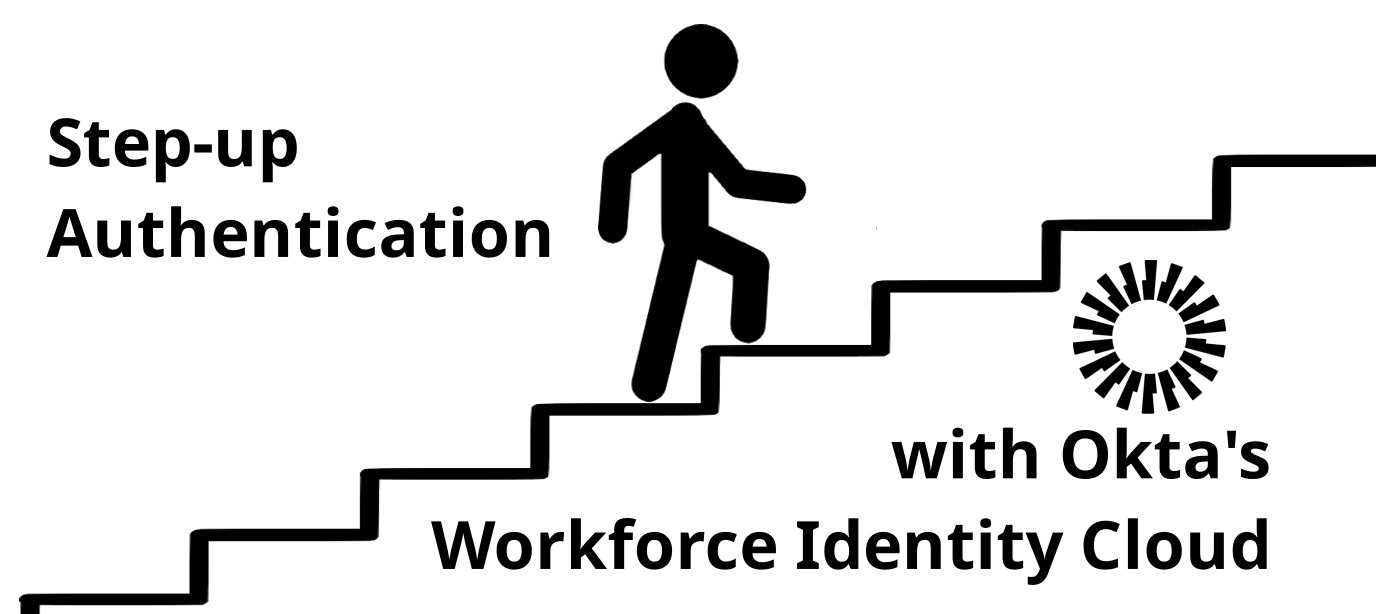Step-Up Authentication Examples With Okta

Step-up Authentication with Okta Workforce Identity Cloud
Step-up authentication in an application is a pattern of allowing access to non-critical resources using basic level of authentication, and requiring additional authentications for critical resources. This has the effect of providing a balance between frictionless user experience and security in an application.
There are several methodologies to provide the functionality as discussed here.
In this article we will explore few ways Okta Workforce Identity Cloud (WIC) can support step-up authentication in an application.
Modern Application using OpenID Connect (OIDC)
Using ACR values
WIC supports acr_values (Authentication Context Class Reference values) parameter as defined in OIDC specification to provide the step-up authentication functionality.
Scenario
-
Application using OIDC for authentication- It can be a web, single page application (SPA) or native mobile application.
-
The need is to maintain a basic assurance level for a user session after user initially authenticates to the application.
-
When the user accesses a sensitive resource, she should be prompted for step-up authentication using additional authentication factors.
-
Once step-up is successful, the user session should move to a higher assurance level for a specified duration of time.
-
Next time the sensitive resource is accessed within the stipulated period, no more challenges should be presented, ensuring a relatively friction-less user experience.
Solution
-
With OIDC, the above behavior is achievable using
acr_valuesandmax_ageparameters of the/authorizeendpoint. -
WIC has in-built support for these parameters. The behavior is available in both redirect and embedded deployment models, and is supported by both Org and Custom authorization servers.
-
The following diagram describes how WIC processes
acr_valuesduring/authorizecall:

-
Currently WIC supports a pre-defined list of
acr_values. These values are mapped to assurance levels supported in WIC authentication policies. -
The non-Okta specific defined values such as
phrandphrhare taken from this OIDC spec. -
The Okta Developer step-up authentication guide describes the process in more detail.
-
Limitation: Currently it is not possible to define custom
acr_values
Implementation
Authentication API example, requesting step-up authentication. Note the acr_values and max_age parameters in the API:
https://${yourOktaDomain}/oauth2/default/v1/authorize?client_id={clientId}
&response_type=code
&scope=openid
&redirect_uri=https://${yourOktaDomain}/authorization-code/callback
&state=296bc9a0-a2a2-4a57-be1a-d0e2fd9bb601
&acr_values=urn:okta:loa:2fa:any
&max_age=30
Okta Auth JS SDK equivalent of the above API:
oktaAuth.signInWithRedirect(
{acrValues: urn:okta:loa:2fa:any, maxAge: 0}
);
Refer to this sample app for a complete working example.
Re-authenticate (only)
Scenario
-
Application using OIDC for authentication- It can be a web, single page application (SPA) or native mobile application.
-
Every time the user accesses sensitive area of an application, she needs to be prompted for re-authentication.
Solution
OIDC supports such a scenario implicitly.
-
The application will initiate a new OIDC authorization request with WIC.
-
The request will have the value for the
promptparameter login. -
WIC will then force re-authentication (even if there is an existing session).
Implementation
Authentication API example, requesting re-authentication. Note the prompt parameter in the API:
https://${yourOktaDomain}/oauth2/default/v1/authorize?client_id={clientId}
&response_type=code
&scope=openid
&redirect_uri=https://${yourOktaDomain}/authorization-code/callback
&state=296bc9a0-a2a2-4a57-be1a-d0e2fd9bb601
&prompt=login
Okta Auth JS SDK equivalent of the above API:
oktaAuth.signInWithRedirect({prompt: "login"});
Refer to this sample app for a complete working example.
Factor API
What about applications that don’t use OIDC?
Scenario
-
Any web, desktop or native application, not using OIDC to integrate with WIC.
-
A secure middleware/business layer is available to the application, such as in 3-tiered web applications.
Solution
-
WIC supports standalone authenticator/factor operations through the factor API. Applications can leverage those factor APIs to implement step-up authentication.
-
A secure middleware/business layer is needed for server-side processing. This is because the factor APIs are privileged and need to use a static Okta API token. The API tokens used need to be properly protected. Here are some guidelines on API token security.
Implementation
- Grab the Okta User ID
Typically, the user id is available from the ID token issued during authentication process (sub claim), or through user management API
{
"family_name": "Silverman",
"given_name": "Indranil",
"locale": "en-US",
"name": "Jha",
"preferred_username": "myemail@myemaildomain.com",
"sub": "00u9vme99nxudvxZA0h7",
"updated_at": 1490198843,
"zoneinfo": "America/Los_Angeles"
}
curl -v -X GET \
-H "Accept: application/json" \
-H "Content-Type: application/json" \
-H "Authorization: Bearer ${api_token}" \
"https://${yourOktaDomain}/api/v1/users?search=profile.login+eq+%22login%40example.com%22"
- Find the Factor ID for the enrolled user
The Factor ID is available from the factor management API
curl -v -X GET \
-H "Accept: application/json" \
-H "Content-Type: application/json" \
-H "Authorization: Bearer ${api_token}" \
"https://${yourOktaDomain}/api/v1/users/00u15s1KDETTQMQYABRL/factors"
- Example: Issue an SMS Factor challenge
curl -v -X POST \
-H "Accept: application/json" \
-H "Content-Type: application/json" \
-H "Authorization: Bearer ${api_token}" \
-d '{
}' "https://${yourOktaDomain}/api/v1/users/00u15s1KDETTQMQYABRL/factors/smsszf1YNUtGWTx4j0g3/verify"
- Example: Verify an SMS Factor challenge
curl -v -X POST \
-H "Accept: application/json" \
-H "Content-Type: application/json" \
-H "Authorization: Bearer ${api_token}" \
-d '{
"passCode": "123456"
}' "https://${yourOktaDomain}/api/v1/users/00u15s1KDETTQMQYABRL/factors/smsszf1YNUtGWTx4j0g3/verify"
Okta Access Gateway
Scenario
-
Legacy web application supporting header based authentication
-
The application is integrated with WIC leveraging Okta Access Gateway(OAG) Web Access Management (WAM) solution
Solution
- OAG can enforce step-up authentication for sensitive resources by cleverly crafting the advanced policies
Transactional MFA
Transactional MFA is a close cousin of step-up authentication. In some step-up cases, transactional MFA can be used instead.
Scenario
-
User authenticates to the application.
-
At some point the user tries to access a sensitive resource.
-
User receives a push notification in her mobile to approve the transaction.
-
Once approved, the access is granted to the resource.
Solution
Okta supports the above transactional MFA scenario using OIDC Client-Initiated Backchannel Authentication Flow (CIBA)
We will look at CIBA based scenario in more detail in a later article.
In summary
Whether you application is using modern protocols such as OpenID Connect or built from legacy technologies, Okta’s Workforce Identity Cloud can help you prompt users to step-up their authentication only when necessary for accessing sensitive resources.
Remember to follow us on Twitter and subscribe to our YouTube channel for more exciting content. Leave us a comment below.
Okta Developer Blog Comment Policy
We welcome relevant and respectful comments. Off-topic comments may be removed.